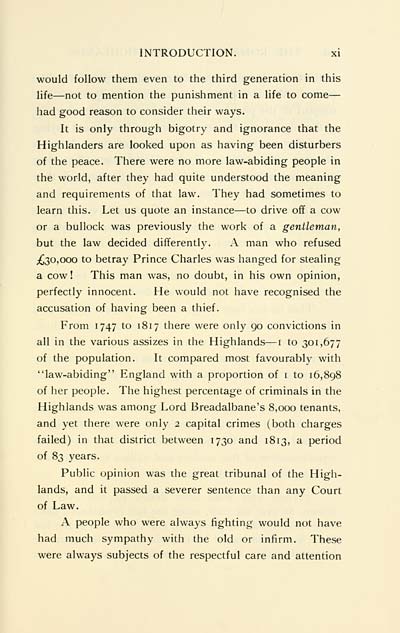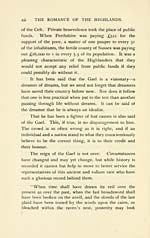Download files
Complete book:
Individual page:
Thumbnail gallery: Grid view | List view

INTRODUCTION. xi
would follow them even to the third generation in this
life — not to mention the punishment in a life to come —
had good reason to consider their ways.
It is only through bigotry and ignorance that the
Highlanders are looked upon as having been disturbers
of the peace. There were no more law-abiding people in
the world, after they had quite understood the meaning
and requirements of that law. They had sometimes to
learn this. Let us quote an instance — to drive off a cow
or a bullock was previously the work of a gentleman,
but the law decided differently. A man who refused
;£30,ooo to betray Prince Charles was hanged for stealing
a cow ! This man was, no doubt, in his own opinion,
perfectly innocent. He would not have recognised the
accusation of having been a thief.
From 1747 to 181 7 there were only 90 convictions in
all in the various assizes in the Highlands — i to 301,677
of the population. It compared most favourably with
"law-abiding" England with a proportion of i to 16,898
of her people. The highest percentage of criminals in the
Highlands was among Lord Breadalbane's 8,000 tenants,
and yet there were only 2 capital crimes (both charges
failed) in that district between 1730 and 1813, a period
of 83 years.
Public opinion was the great tribunal of the High-
lands, and it passed a severer sentence than any Court
of Law.
A people who were always fighting would not have
had much sympathy with the old or infirm. These
were always subjects of the respectful care and attention
would follow them even to the third generation in this
life — not to mention the punishment in a life to come —
had good reason to consider their ways.
It is only through bigotry and ignorance that the
Highlanders are looked upon as having been disturbers
of the peace. There were no more law-abiding people in
the world, after they had quite understood the meaning
and requirements of that law. They had sometimes to
learn this. Let us quote an instance — to drive off a cow
or a bullock was previously the work of a gentleman,
but the law decided differently. A man who refused
;£30,ooo to betray Prince Charles was hanged for stealing
a cow ! This man was, no doubt, in his own opinion,
perfectly innocent. He would not have recognised the
accusation of having been a thief.
From 1747 to 181 7 there were only 90 convictions in
all in the various assizes in the Highlands — i to 301,677
of the population. It compared most favourably with
"law-abiding" England with a proportion of i to 16,898
of her people. The highest percentage of criminals in the
Highlands was among Lord Breadalbane's 8,000 tenants,
and yet there were only 2 capital crimes (both charges
failed) in that district between 1730 and 1813, a period
of 83 years.
Public opinion was the great tribunal of the High-
lands, and it passed a severer sentence than any Court
of Law.
A people who were always fighting would not have
had much sympathy with the old or infirm. These
were always subjects of the respectful care and attention
Set display mode to: Large image | Transcription
Images and transcriptions on this page, including medium image downloads, may be used under the Creative Commons Attribution 4.0 International Licence unless otherwise stated. ![]()
| Early Gaelic Book Collections > Ossian Collection > Romance of the Highlands > (19) |
|---|
| Permanent URL | https://digital.nls.uk/81815853 |
|---|
| Description | Selected books from the Ossian Collection of 327 volumes, originally assembled by J. Norman Methven of Perth. Different editions and translations of James MacPherson's epic poem 'Ossian', some with a map of the 'Kingdom of Connor'. Also secondary material relating to Ossianic poetry and the Ossian controversy. |
|---|
| Description | Selected items from five 'Special and Named Printed Collections'. Includes books in Gaelic and other Celtic languages, works about the Gaels, their languages, literature, culture and history. |
|---|

